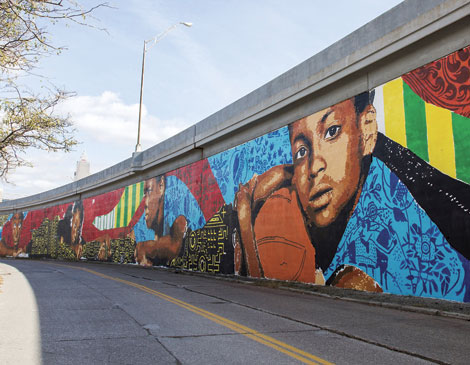Ananda Nahú didn’t just dip brushes into paint cans — she saturated herself with history and culture. For a month before beginning the 620-foot-long mural along Washington Avenue, the Brazilian native researched ancient African traditions and interviewed Ohio City residents to accurately reflect the vibrancy of the community. Created during the Cleveland Foundation’s Creative Fusion project last fall, Nahú’s mural of striking portraits was the largest work among 11 projects. With such an immense canvas, the 31-year-old’s work needed to match its scale. “The mural is alive,” she says. “It’s a big amulet that is protecting the community.”
Nahú met the six kids she painted through Brick City, a Cleveland Public Theatre arts program for children who are Cleveland Metropolitan Housing Authority residents. “My purpose was something very natural,” she says. “The kids are representing the community — the future.”
The yellow, black and blue designs that fill the background are inspired by Nigerian and Congolese symbols worn by priests for spiritual protection. Nahú projected the designs onto the wall by day, and local artists Adam Zimmerman, Gary Williams and others helped fill them in. “I changed all the textiles I found,” says Nahú. “I changed colors, added some information. But the meaning remains the same.”
It’s not just African symbols that morph into the background: Green and yellow stripes represent Nahú’s home country and Cleveland’s Latino population. “Each culture is very visible in each layer,” she says, “but in the same way, they are mixed so they don’t miss their own identity.”
Nahú points to the shyness of the children, especially Jariah Edmond, the first kid she met. At first Edmond didn’t want to be in the mural but seeing herself in paint changed everything. “I saw her transformation from a shy girl to a very confident girl,” says Nahú.
Thirteen-year-old Montrell Barron curves his arm to grasp the basketball he habitually clung to. During the six weeks Nahú painted, Montrell dropped his ball for the handle of a brush to help her fill the orange circles. “It’s the first time he touched a brush,” she says. “It’s good to bring this feeling to the community to assimilate art in some way.”
In Nigeria, the color red symbolizes wealth and power. Nahú’s organic red and dark red designs embody this idea, as well as the common blood that unites all people. “It’s to give a sensation that the mural is alive, in the same way to give the kids a way of importance — being strong like a king,” she says. “Majesty.”

A New Ohio City Mural Paints a Community of Togetherness
Brazilian native Ananda Nahu's 620-foot-long piece of art pay tribute to local residents.
entertainment
9:00 AM EST
February 9, 2017



